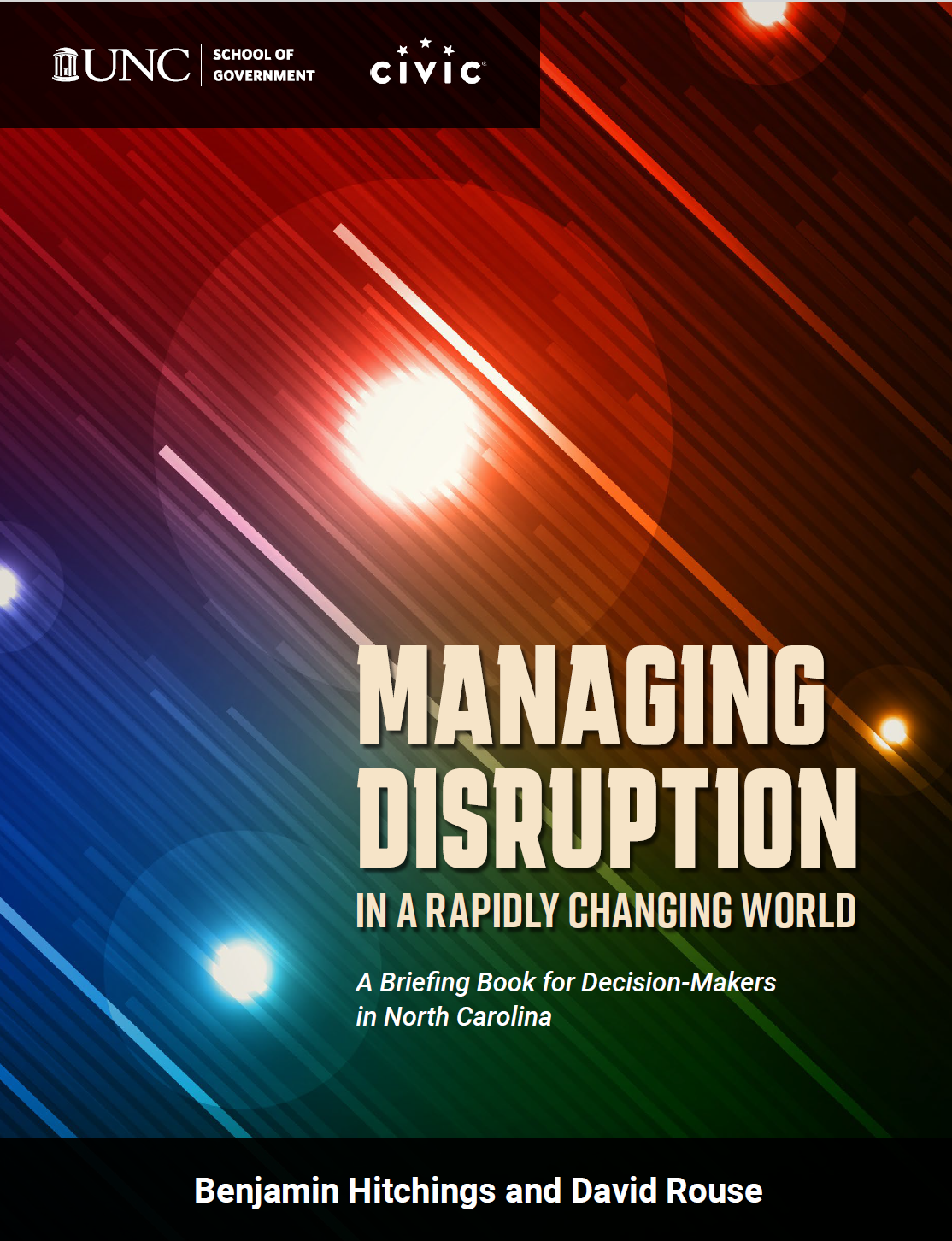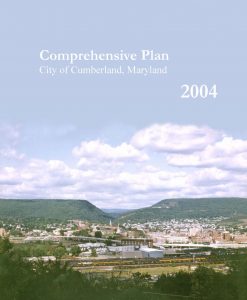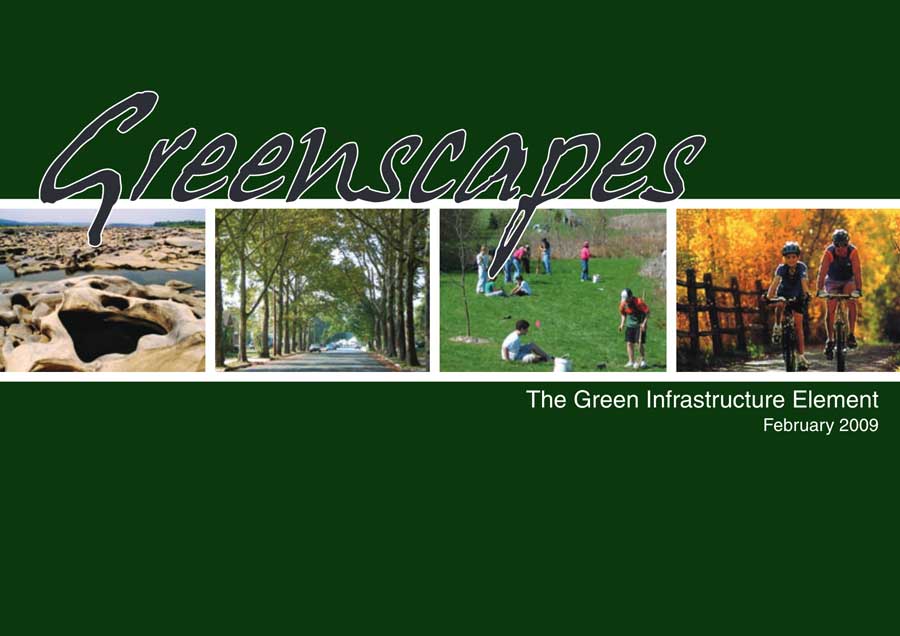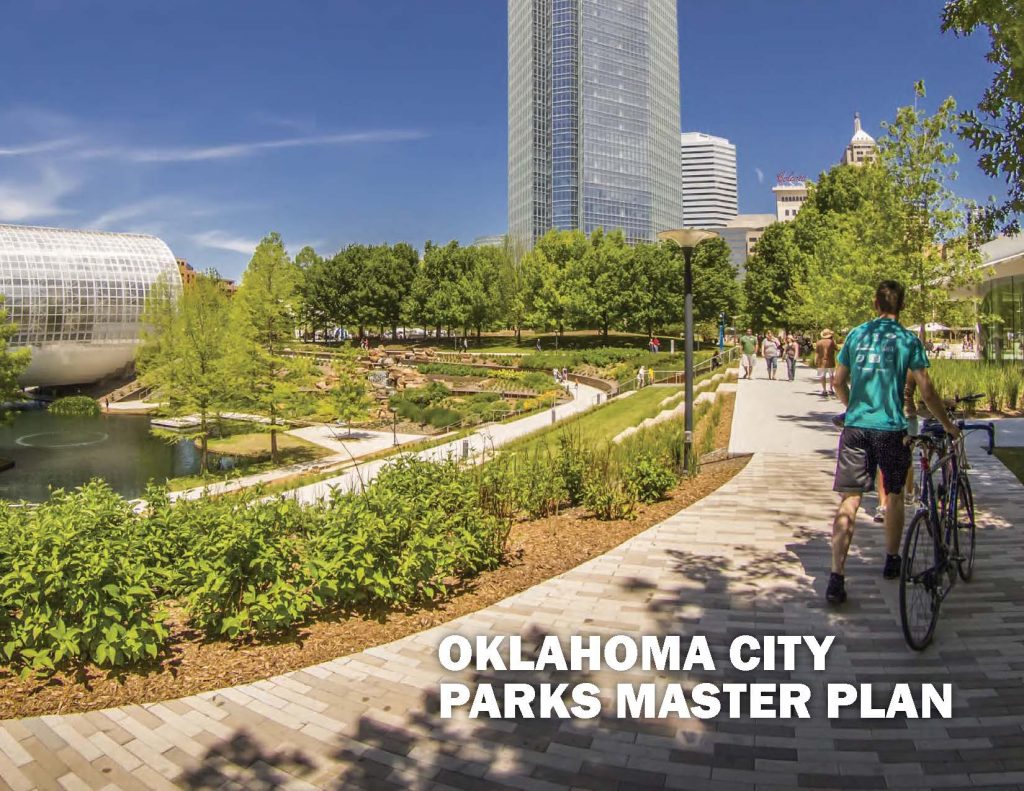Managing Disruption: A Briefing Book for Decision-Makers in North Carolina

David Rouse and Benjamin Hitchings (principal of Green Heron Planning in Durham, NC) were retained by the UNC School of Government to prepare a briefing book as the first product of its Growing Practical Solutions for North Carolina initiative. The briefing book is designed as a resource for decision-makers representing North Carolina communities, regional councils, state agencies, and others seeking to manage the disruptive impacts of change. Funding for the briefing book was provided by the Civic Federal Credit Union.
The briefing book is organized around the Drivers of Change Framework developed by Hitchings and Rouse and first applied in the Triangle Trends Report prepared for the Triangle J (now Central Pines) Regional Council of Governments. Drivers of change are macro-level forces – social, technological, economic, and environmental – that impact current conditions, trends, or systems, creating the need for adaptation and strategic response by local communities. The briefing book describes how to use the framework, provides concise write-ups on 16 representative drivers of change, and lays out a six-step process for how local and regional governments can prepare strategic readiness plans to increase their resilience. With this resource in hand, decision-makers can identify the drivers of change that are most relevant to their community, assess the implementation measures that will help them best respond, and work systematically to better prepare for the future.
Imagine Austin Comprehensive Plan
A large, fast-growing city in Central Texas, Austin is home to the state capitol, University of Texas, and is renowned for its creative economy and music scene. With its many assets Austin has been experiencing issues and challenges related to growth and change, such as maintaining the qualities that make it a great place to live, expanding transportation choices, tackling the ethnic divide, and creating opportunities for all segments of the population in a majority-minority city.
In 2009 the city embarked on a comprehensive planning process to replace Austin Tomorrow, its last adopted comprehensive plan, which dated back to 1980. Key goals set by City Council were inclusive participation during the process and establishing sustainability as the central policy direction of plan. The city selected WRT to serve as the lead consultant for the plan, with David Rouse as project director.
The plan was shaped by robust community engagement. The process included analysis of existing conditions and trends in a city projected to add approximately 750,000 additional people within the 30-year time horizon of the plan; articulation of a vision for the future based on the values and aspirations of residents; synthesis of scenarios generated by residents into a growth concept map; and detailing of policies, programs, and actions to implement the vision and growth concept. Reflecting contemporary comprehensive planning practice, Imagine Austin is organized around interconnected themes rather than discrete elements as called for by the city charter. The theme of a compacted and connected city provides a new growth paradigm that integrates land use and transportation in a system of centers and corridors. These themes were the basis for eight priority programs identified by the plan to organize implementation efforts by interdepartmental work teams. Information on the city’s ongoing implementation efforts can be found on the Imagine Austin website.
Cumberland, MD Comprehensive Plan

Located on the Potomac River and the historic terminus of the C&O Canal in Western Maryland, Cumberland, MD was a historic transportation hub and manufacturing center that experienced population decline after 1950, largely due to loss of its industrial base. Building on the city’s role in the nation’s history of transportation, Cumberland’s Canal Place was designated as Maryland’s first heritage area in 1993 and WRT was selected to prepare the Management Plan for the heritage area. Canal Place has since grown into an important economic development asset whose mission is to preserve local heritage and bring Cumberland’s rich history to life for visitors and residents.
The Canal Place Heritage Area Management Plan was completed in 1995. The City of Cumberland then asked WRT, with David Rouse as project manager, to develop a new comprehensive plan defining a vision and new direction for Cumberland looking 25 years into the future. Developed with the input of city residents, stakeholders, and leaders, the plan established a simple, straightforward vision for Cumberland in the year 2020 as an excellent place to live, an enjoyable place to visit, and a supportive place to build a profitable business. Plan strategies included, among others, leveraging Canal Place and the heritage tourism industry as a catalyst for economic development and downtown revitalization; preserving scenic views and resources; improving access and circulation; and amending the zoning ordinance and taking other actions to facilitate the start-up and growth of new businesses.
Over the next decade David Rouse led WRT’s work on a series of additional projects for the city, including a complete zoning ordinance revision, a strategic plan, a 2004 update to the comprehensive plan, and a sustainable economic development plan. More than 25 years after the first comprehensive plan was adopted, the impact of this body of work is manifest in renewed investment and Cumberland’s growing reputation as an excellent place to live and visit.
Lancaster County, PA Green Infrastructure Plan

Lancaster County, PA is renowned for its scenic landscapes, agricultural productivity, and the cultural heritage of its Plain Sect (Amish and Mennonite) communities. In 1993 the County adopted its first growth management plan, which established Urban Growth Areas (UGAs) for use by municipalities to direct growth away from agricultural and natural resource lands. In 2006 Lancaster County adopted Balance as its “second generation” growth management plan. Balance defined an Urban Growth Area Strategy and a Rural Strategy to maintain the County’s rural character for future generations while focusing and improving the character of new development in UGAs. WRT, with David Rouse as project manager, was the lead consultant for this effort.
David Rouse also led WRT’s work on Greenscapes, the Green Infrastructure Element of the Lancaster County Comprehensive Plan, which was adopted by the County in 2009. Greenscapes defined a vision, goals and objectives, strategies, and tools to preserve, conserve, restore, and enhance natural resources through a countywide green infrastructure system. While essential to Lancaster County’s identity and economy, agricultural lands are not considered part of this system for two primary reasons: 1) they are a permanent land use on par with developed uses such as residential and commercial; and 2) agriculture has extensively altered the County’s native plant and animal communities and impacted the quality of its rivers and streams. Rather, Greenscapes acknowledges farmland as the landscape context for much of the green infrastructure system and identifies contributions that can be made by farmers to system health, such as establishing riparian buffers, controlling runoff to improve water quality, and managing lands to enhance habitat value.
Greenscapes’ implementation component emphasizes the need for cross-sectoral collaboration by government, institutions, nonprofits, civic groups, private landowners, developers, and businesses to create the green infrastructure system. It provides a toolbox of 45 specific implementation tools that can be used by these diverse interests, divided into four broad categories: policy and planning, regulation, capital investment, and outreach and partnerships.
Lancaster County adopted a new comprehensive plan, places2040, in 2018. Greenscapes is incorporated by reference into the new plan and continues to inform the County’s efforts to establish a healthy, robust green infrastructure system.
Oklahoma City Parks Master Plan

WRT, with David Rouse as principal-in-charge, was selected by Oklahoma City and the Oklahoma City Community Foundation as the lead consultant for a new Parks Master Plan. Plan preparation was coordinated with the the planning process for Oklahoma City’s new comprehensive plan, planokc. Adopted in 2013, the Master Plan defines how the city will maintain, improve, and grow its parks system to improve quality of life, enhance economic vitality, and help achieve one of planokc’s “Big Ideas” – building an urban environment that facilitates health and wellness.
The plan sets six strategic directions to guide Oklahoma City in establishing new policies and programs, developing new partnerships, and allocating funding and resources to achieve the Park Department’s mission to “provide great parks, public areas, and quality cultural and leisure time opportunities for our citizens and visitors.” These directions are to maintain and improve physical assets of existing parks; develop facilities and programs to meet community needs; improve access to parks; promote and increase awareness of the value of parks; develop new parks and facilities to meet the needs of a growing population; and establish agreements and standards for private parks and school parks. The Master Plan identifies actions for the city and its partners to take to implement each of the six strategic directions.
Other Master Plan components include a park classification system, level of service standards, park maintenance guidelines, and funding options and strategies for three order-of-magnitude cost scenarios over the 20-year time horizon of the plan. These scenarios range from $480 million for “business-as-usual” to $1.3 billion needed to fully fund the plan proposals related to investments in existing parks, improving park access (e.g., via new sidewalks and trails), developing new parks and facilities, and promoting increased awareness of the value of parks.

